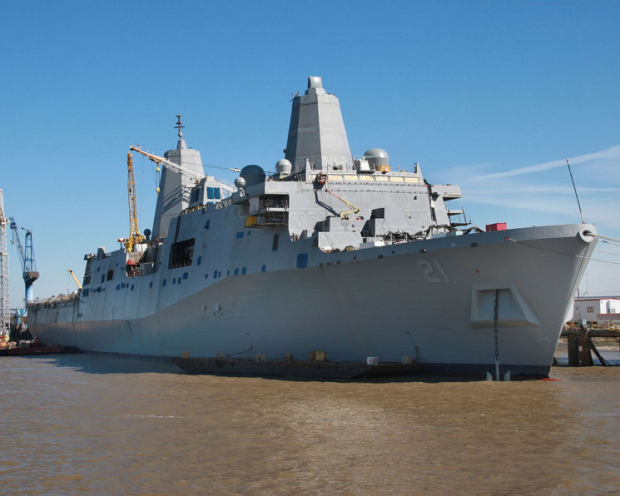TECHNOLOGY
A SHIP THAT GOES ANYWHERE
26 Jan 2010

The San Antonio class amphibious transport ships are capable of sending marines and their gear to anywhere in the world, plus they boast a whole host of features that makes them a worthy addition to the United States Navy's fleet.
While the San Antonio class ships may not possess the glamour of aircraft carriers or the sleek silhouettes of destroyers, they give the US Navy (USN) the important capability of landing their elite Marines the amphibious infantry assault force of the US Armed Forces anywhere in the world.
A successful amphibious landing of infantry troops clears the way for other friendly forces to enter enemy territory and can change the course of a war, as proven by the D-Day landings of World War II.
Such missions are exactly what the San Antonio class ships are built for.
And the ship is big: The USS New York the fifth and latest San Antonio class vessel of nine that the USN ordered stands at the equivalent of 18 storeys and measures 208 m long or roughly the length of eight basketball courts.
Space for an army
The reason for this imposing size is clear once you know what the ships are built to hold: nearly 800 marines and their gear as well as various rotary-winged aircraft, making the San Antonio class ships veritable floating armies when fully loaded.
Within the San Antonio class ships are 139 sq m hangar spaces that can accommodate up to four aircraft, depending on the type. This hangar space can house up to four AH-1 Cobras which are single-engined attack helicopters, or an MV-22 Osprey, a tilt-rotor aircraft capable of vertical take-off, with a 14m wingspan. In addition, the flight deck can hold another two MV-22 Ospreys.
The ship does not have full-time aircraft mechanics on board, but its hangar crew are capable of providing basic maintenance. "We have everything we need here to sustain an Osprey for deployment," said Lieutenant Terry Menteer, who is in charge of the USS San Antonio's flight deck. The USS San Antonio is the first of this namesake class and it was commissioned in January 2006.
The ship carries its occupants in comfort too, with widened passageways to accommodate the Marines' bulky rucksacks and weapons. An improved armoury location near the ship's exit increases the Marines' speed when moving out for a mission. This way, the Marines receive their weapons just before they leave the ship, in contrast to the old practice of holding the troops while they drew their personal weapons.
There are separate quarters in the ship for male and female crew. Meters and instrument panels throughout the vessel are installed at lower heights to accommodate the female crew members, who are generally shorter.
Enhanced survivability
With the potential to carry so many of the US Armed Forces' assets and personnel, crew survivability becomes ever more important.
The San Antonio class ships incorporate stealth design features such as clean lines and flat outward surfaces which reduce the ships' radar signatures. To meet the USN's requirements, Northrop Grumman's research and development created a process of making ultra-flat steel surfaces, called flame straightening.
This technique involves the application of heat to small areas on the metal plate and rapidly cooling the plate, causing it to contract and eliminate most of the surface irregularities along the way. This was necessary because the heat from welding metal plates often caused them to warp imperceptibly, something which might seem unimportant to the naked eye, but drastically increases the ships' radar signatures.
In addition, all external structures such as antennae are hidden under metal panels or can be stowed away below deck. These metal panels are coated with special composites and materials which absorb radar waves. The glass windows are treated with a reflective film. All these efforts achieve one aim: making the San Antonio class ships appear as small as possible on radar.
The contract for the San Antonio class ships was awarded to Northrop Grumman Shipbuilding in 1996. The first of this class, the USS San Antonio, was commissioned on 14 Jan 06. Most recently, the USS New York was commissioned on 7 Nov 09. Of special significance is the USS New York's hull, which was built partially from the wreckage that resulted from the 9/11 attacks. The USN is expected to take delivery of its ninth San Antonio class ship the USS Somerset in 2012.
ALSO READ IN TECHNOLOGY

AI joins the fight in national cyber defence exercise
12 Nov 2025
AI and closer collaboration among agencies and industry are taking centre stage in this year’s Critical Infrastructure Defence Exercise (CIDeX).

They built this city
01 Oct 2025
Turning vision to reality: the team behind SAFTI City clinches the Defence Technology Prize 2025 Team (Engineering) Award!

Operating over skies & seas
22 Aug 2025
This gear is designed to help a Sensor Supervisor survive emergencies in the air and at sea.






